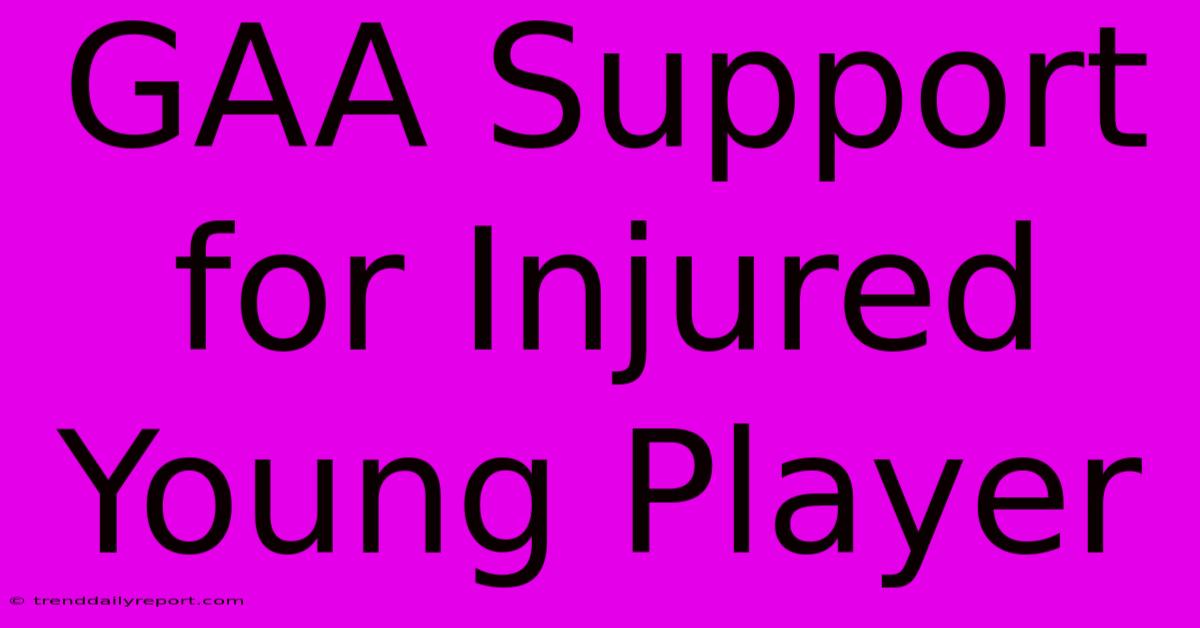GAA Support For Injured Young Player

Discover more detailed and exciting information on our website. Click the link below to start your adventure: Visit Best Website GAA Support For Injured Young Player. Don't miss out!
Table of Contents
GAA Support for Injured Young Players: A Parent's Perspective
So, my kid, Liam, he's a whirlwind on the pitch. A little GAA rocket, as his coach sometimes calls him. But last month, bam, a nasty ankle twist during a U14 match. Suddenly, all that energy, all that passion, was sidelined. It sucked, absolutely sucked. But you know what? The experience showed me a side of the GAA I hadn't fully appreciated before – the support system for injured young players.
<h3>Navigating the Injury: First Steps</h3>
The initial panic was real. Liam was crying, clutching his ankle, and I was a mess of adrenaline and worry. I'd never seen him in so much pain. Thankfully, the club's first aider was on the ball. She assessed the situation, got him iced down, and helped get him to the hospital. This is crucial, folks: having a trained first aider present at every match is non-negotiable. It's a basic safety measure that every GAA club should prioritize.
The diagnosis was a sprained ankle, thankfully not broken, but it still meant weeks of physiotherapy, crutches, and a whole lot of downtime. My initial thoughts were entirely focused on Liam's physical recovery. I was calling physios, researching exercises, and trying to keep his spirits up. But I soon realised there's more to recovery than just physical therapy.
<h3>The GAA Community Rallies Around</h3>
What truly surprised me was the incredible support from the GAA community. It wasn't just the club officers, either, although they were fantastic in keeping me updated and helping with arrangements. It was the other parents, the coaches, even the other kids on the team. They sent cards, texts, and even little care packages. I felt a massive sense of community, which was invaluable during a tough time.
The team visited Liam in the hospital with gifts, and then later made sure he didn’t miss out on team functions. They kept him involved in team chats and activities even though he couldn't physically participate. They even organised a special team visit to his house.
This social aspect is crucial for a young player's mental health. Feeling excluded when injured can be just as damaging as the physical injury itself. This is something every GAA club should aim to foster.
<h3>Practical Tips for GAA Clubs Supporting Injured Players</h3>
Based on my experience, here’s what I think GAA clubs can do to improve support for injured young players:
- Establish clear communication channels: Keep parents informed about treatment options, recovery timelines, and opportunities for involvement. Regular updates are essential.
- Promote social inclusion: Find ways to keep injured players connected to the team. Invite them to training sessions, games, or even just social gatherings.
- Provide access to professional support: This isn't always possible, but access to sports psychologists or counsellors can be invaluable in dealing with the mental aspects of injury.
- Organize fundraising initiatives: Medical bills and physiotherapy can be expensive, so fundraising can ease the financial burden on families.
Liam's recovery wasn't easy. There were tears, frustrations, and days when he just wanted to give up. But the unwavering support from the GAA community made a huge difference. He’s back on the pitch now, stronger and more determined than ever. It's a testament to the resilience of young athletes and the power of community. The GAA isn't just about the games; it's about nurturing young people, on and off the field. That's something I'll never forget. And that, my friends, is why the GAA is so special.

Thank you for visiting our website wich cover about GAA Support For Injured Young Player. We hope the information provided has been useful to you. Feel free to contact us if you have any questions or need further assistance. See you next time and dont miss to bookmark.
Featured Posts
-
Instagram Star Magpies License Revoked
Nov 27, 2024
-
Laos Arrests Impact Bowles Jones Families
Nov 27, 2024
-
Su Rvers Season 12 New Faces
Nov 27, 2024
-
Mc Gregors Whiskey Supplier Switch
Nov 27, 2024
-
Bayern Defeats Psg 1 0 Live Blog
Nov 27, 2024
